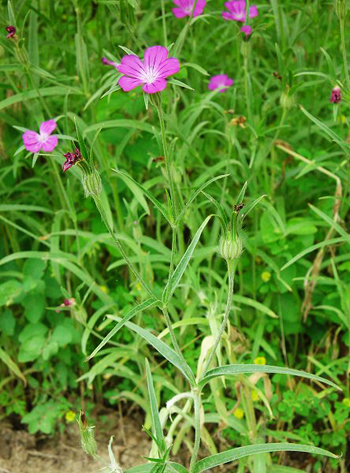Contents:
Parts Usually Used | Plant(s) & Culture | Where Found
Uses | Warning | Bibliography
Scientific Names

- Agrostemma githago L.
- Pink family
Parts Usually Used
Seeds
Back to Top
Description of Plant(s) and Culture
A tall silky biennial or annual weed (agrostemma githago), grows 1-3 feet tall, of the pink family, with flat, pinkish flowers and poisonous seeds. The leaves are lance-shaped; petals deep pink, veined. Flowers June to September.
Back to Top
Where Found
Noxious weed often found in grain fields, waste places. Throughout the United States.
Back to Top
Uses
Minute amounts of powdered seeds once taken in honey as a diuretic, expectorant, vermifuge (dewormer); used for jaundice, dropsy, and gastritis. Some European folk use for cancers, warts, and hard swellings in the uterus.
Back to Top
Warning
Seeds are toxic, especially when broken; dangerous saponins are concentrated in seed embryo.
If seeds are to be used, do so only with medical supervision.
Back to Top
Bibliography
![]() Eastern/Central Medicinal Plants
Eastern/Central Medicinal Plants, by Steven Foster and James A. Duke., Houghton Mifflin Company, 215 Park Avenue South, New York, NY 10000
![]() Webster’s New World Dictionary
Webster’s New World Dictionary, Third College Edition, Victoria Neufeldt, Editor in Chief, New World Dictionaries: A Division of Simon & Schuster, Inc., 15 Columbus Circle, New York, NY 10023
